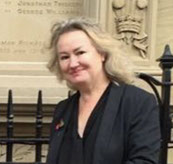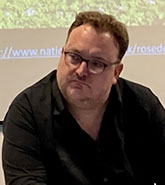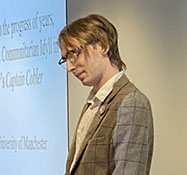
Newport Chartist Convention 2024: Speakers
Julie Nicholas

The Lady Rhondda Statue Campaign.
Abstract: Monumental Welsh Women is a not-for-profit organisation whose mission is to recognise the contribution of women to the history and life of Wales, ensuring Welsh women’s stories become a part of the cultural land-scape. To this end the campaign aims to unveil monuments to 5 real Welsh women in 5 years. Newport's Lady Rhondda was the 4th statue, unveiled in Newport on 26th September 2024. Julie Nicholas, Chair of the Statue for Lady Rhondda steering group, will talk about the statue by artist Jane Rob-bins, the progress of the Monumental Welsh Women campaign, and the remarkable life of Margaret Haig Thomas, Viscountess Rhondda.
Nick Venti and Nia Griffiths


Causes and Characters of the Chartist Riot in Llanidloes in 1839.
Abstract: The Newport Rising is the most celebrated event in early Chartism. It marked the disappointing end of a year which had opened with high expectations from the General Convention of the Industrious Classes and the presentation of the National Charter to Parliament. Less renowned, but no less significant, were events in Llanidloes in April, when attempts to arrest local Chartist leaders led to a riot in which the established forces of law and order were overthrown and the town placed effectively under the control of the Chartists for five days. It was the Llanidloes riot that first provoked the imposition of repressive measures against the Movement, leading to the arrest of its leaders and the growing sense of desperation that manifested itself in the march on Newport. But how did Chartism take root in mid Wales and who were the people, on both sides of the political divide, who found themselves caught up in the ‘Pum Diwrnod o Ryddid’ (Five Days of Freedom)?
Matthew Roberts

Heritage Politics and Memories of Chartism in Wales 1918-2020
Abstract: Chartism, the working class movement for democratic and social rights which swept across Britain from the 1830s to the 1850s, has enjoyed a remarkably enduring posthumous life. This lecture focuses on the politics of remembering the movement in Wales. In doing so, it suggests that three key memories of Chartism have been invoked: 1) the Fabian view; 2) the militant proletarian view; 3) and Chartists as premature liberal democrats. By drawing on critical heritage studies, as well as a range of familiar and unfamiliar material – from press reports to ephemera and the built environment - this talk shows how forms of remembrance and the practices of commemoration surrounding Chartism were (and are) far from static and repetitive but evolving, dynamic and contested.
Jonathan Edwards

Poetry reading
Jonathan Edwards has been fascinated by Chartism since he was first introduced to it by a number of inspirational History teachers, and his poems are inspired by the working-class history of Wales. His first collection, My Family and Other Superheroes (Seren, 2014), received the Costa Poetry Award and the Wales Book of the Year People’s Choice Award. His second, Gen (Seren, 2018), also received the Wales Book of the Year People’s Choice Award, and in 2019 his poem about Newport Bridge was shortlist-ed for the Forward Prize for Best Single Poem. He lives in Crosskeys, South Wales, and is Royal Literary Fund Fellow at Cardiff University. Jonathan Edwards - Seren (serenbooks.com)
Catherine Howe
Feargus O'Connor
Abstract: William Ashton’s allegations made between 1842 and 1845 against Feargus O’Connor, that he ran away to Ireland a month before the Newport rising and was the betrayer of John Frost, were raised by William Lovett in his autobiography of 1876 and have been visited by O’Connor biographers Donald Read and Eric Glasgow (1961), James Epstein (1982), and Paul Pickering (2008). So the controversy has successfully carried down the decades via successive historians. But it is not the fact of Feargus O’Connor’s journey to Ireland, which he made so close to the time of the Newport rising, or the failure to pass on William Ashton’s urgent message about Yorkshireman Bussey’s backing-off which is of primary concern here, rather, it is the back-ground story to how and why the allegations were made: it places the controversy in the context of fragile egos and small human failings within the Chartist leadership at a time when men and women were facing soldiers, when revolutionaries marched down Stow Hill, when many were killed and even more prosecuted and imprisoned. It is a labyrinthine yet, hopefully, interesting and informative tale.
Ray Stroud

The Thomas Phillips subscriber plate
Abstract: In 1982, Newport Museum and Art Gallery acquired a peculiar artefact. It was a tarnished piece of silver, which had been purchased in a Colchester scrapyard with the intention of welding it onto a rusty motor vehicle. Fortunately, when the new owner noticed some engraved marks showing through the grime, he took it to his local museum. The item turned out to be the only known surviving piece of a silver service given by New-port Corporation to the Mayor of Newport, Sir Thomas Phillips, for his role in the Newport Rising of 1839. It is likely that the silver plate had moved to Essex when his relative, Thomas Phillips Price (1844-1932), sold Triley Court, near Abergavenny. The plate is engraved with the names of all the Corporation members at the time, together with other local notaries who wished to record their appreciation of the Mayor’s personal valour. While all the other parts of the service are still missing, the silver plate is now on display in Newport Museum.
Duncan Hamilton

Six Points, Five Acts: The Newport Rising on the Chartist Stage
Abstract: Drama was extremely important to many Chartists. Not only did the medium offer a form of political education for Chartists themselves, but the staging of popular plays was often useful in the raising of funds and the spreading of their democratic principles to a broader public. It also provided working-class radicals with vital opportunities for self-expression, imagination and creativity, all of which lent their energies to the transformative set of principles that underpinned the Chartist campaign. Classics were common - Shakespeare was a favourite of many - but on occasion, Chartists tried their hand at self-written plays, acting out important moments in the movement’s history and contributing to Chartism’s rich internal dialogue. The Newport Rising was one such moment acted out upon the stage. Writ-ten by the Whitby Chartist John Watkins, it was published and first staged in 1841, under the title John Frost: a Play in Five Acts. This paper examines the Rising’s depiction in Watkins’s play, as well as characters such as John Frost, Mary Frost and George Shell, to consider how the play seeks to re-member the Newport Rising. Is the play’s Rising a valiant struggle in the cause of democracy, a futile attempt to subvert a dominant state, or a bloody celebration of the merits of physical force?









